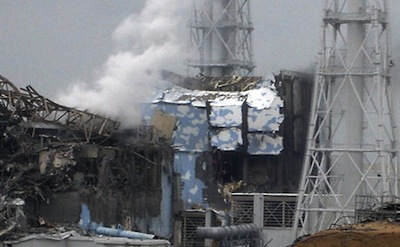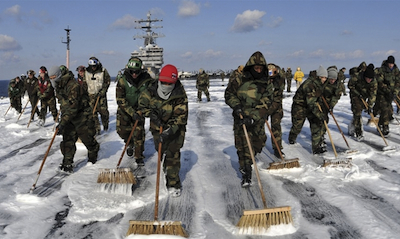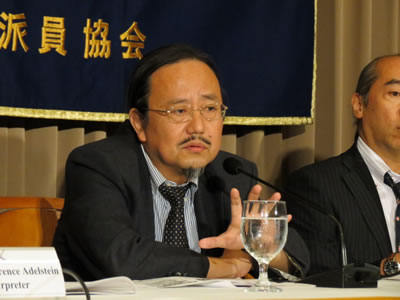
News out of Fukushima has been difficult to come by. After the spent fuel removal supposedly began in Unit 4 in November, the media went even more silent than usual. That in turn has been fomenting all kinds of speculation, some of which turns out to have a factual basis. The Internet has been abuzz over speculations that a meltdown is occurring in the spent fuel pool of Reactor 3. TEPCO, the utility that owns the plant, officially reported on four separate days in December that steam was seen rising from the wreckage of the Reactor building.
The Reactor 3 nuclear core went into meltdown on March 13, 2011, after an explosion caused by a hydrogen buildup. The exact status of the melted core is unknown and it is speculated to have melted entirely through the containment vessel. Following the 2011 explosion, a large plume of radiation was emitted, and was carried to the U.S. on wind currents at that time. TEPCO has not been clear about what's causing the rising steam. Extremely high and lethal levels of radiation in the building prevent anyone from getting close enough to find out. Remote-controlled cranes and equipment are being used to remove debris and rubble from the damaged Reactor building, a process that began, unbeknownst to the public, on Dec. 17, 2013. (This is not the same as the removal of fuel from Reactor 4, which Planet Waves covered here.) According to TEPCO, the steam is being emitted from the fifth floor of the building. Currently, 566 used and unused fuel assemblies sit in the spent fuel pool of Reactor 3. Some reports claim the Reactor 3 storage pool also contains highly dangerous MOX fuel, which consists of mixed uranium and plutonium oxide; however, there is conflicting data about whether there is MOX fuel in the pool or not. According to the TRN article, experts warn that the rising steam "could be the beginning of a spent fuel pool criticality," meaning that there could be an atomic reaction starting in the spent fuel pool, where it cannot be contained. Other possibilities include corium (from the melted Reactor) reaching groundwater; rainwater coming into contact with stray fuel elements; or "mini" meltdowns of stray pellets (ejected during the explosion) boiling off the water in the fuel pool. Other unknown causes are also likely. Other researchers and experts claim the steam is nothing new and not an urgent concern. According to a recent statement released by Fairewinds Energy Education, "Our research, and discussions with other scientists, confirms that what we are seeing is a phenomenon that has been occurring at the Daiichi site since the March 2011 accident." According to Fairewinds, hot water vapor has been released daily from all four Reactors at Fukushima Daiichi ever since the accident occurred. Due to the cold winter weather in the northern hemisphere, the water vapor becomes visible due to condensation. The cause of the steam, according to Fairewinds, is merely the heat given off by decaying radioactive rubble. While the Reactors are no longer operational, cold shutdown is not possible because the atoms left over from the original chain reaction continuously give off heat, releasing fission byproducts. This means the release of radioactive steam is happening daily, but it isn't a problem and is not a recent development, according to Fairewinds. The decay heat released by Reactor 3, less than 1 megawatt, is still a large amount of radiation entering the atmosphere; but Fairewinds claims that Reactor 3 isn't going to explode.
Fukuleaks says that Xenon 135, monitored as an indicator of fission, is well below levels that would indicate a cause for concern. Along with Fairewinds, Fukuleaks says that the steam is nothing new, and something they've been covering for quite some time. Along with official announcements from TEPCO about the mysterious and controversial steam, TEPCO also reported another leak of radioactive water -- just in time for Christmas. Reported as "Fukushima's Christmas Gift to the World" by articles covering the story, 225 tons of radioactive water went missing from two storage tank areas. TEPCO noticed that the water levels suddenly dropped in two tanks, though the areas around the concrete barriers showed no visible signs of water. TEPCO speculates that the water likely seeped into the surrounding soil. On Dec. 20 one area was 12 centimeters deep, but by Dec. 24, it was reduced to 5 centimeters. Another area showed 12 centimeters on Dec. 20, but only had 1 centimeter left by Dec. 24. The water held in these tanks contained radioactive strontium 90, as high as 440 becquerels per liter. This has, so far, been the largest release of radioactive rainwater to escape from the barriers around the tanks. To prevent future leaks, TEPCO plans to apply a non-permeable resin on the inside of the barriers. Let's hope this works. TEPCO believes that cracks in the concrete and the weakening of the resin at connection points of the concrete barriers are the cause of the leaks. Just one week prior to this development, 3.4 tons of radioactive water leaked from Reactor 2. While the mainstream media has completely ignored the ongoing crisis, and with many scientists dismissing the dangers posed to the rest of the world, many signs are emerging that Fukushima is having a definite environmental impact. A recent article posted by Investment Watch, has outlined 36 signs that the media is lying about Fukushima radiation. High radiation levels are being detected on beaches along the U.S. west coast, starfish are dying mysteriously, seals, walruses and polar bears are losing hair, Pacific herring have been found bleeding from eyes and gills, and bluefin tuna and plankton from the Pacific are showing up with radioactive contamination.
The plaintiffs are military personnel who acted as first responders, and rushed unknowingly into a radioactive zone. The desalination tanks on board the ship took in water from the ocean. They were drinking, bathing in and cooking with water from the Pacific as Fukushima Daiichi was releasing billions of gallons of contaminated water into it. Charles Bonner, representing the U.S. crew with co-counsel Paul Garner, stated in an interview on Dec. 10, 2013, “As a result of this exposure, the 51 sailors that we represent right now have come down with a host of medical problems, including cancers and leukemias, all kinds of gynecological problems […] people who are going blind, pilots who had perfect eyesight but now have tumors on the brain.” Bonner said the number of afflicted personnel has grown, and the amended complaint that will be filed Jan. 6, 2014 is expected to include approximately 75 sailors. On a more positive note, journalist Minoru Tanaka has won a quiet victory in Japan’s battle for freedom of press. The lawsuit against him for 67 million yen, the first to target an individual journalist, was dropped in August 2013; the plaintiff withdrew charges after more than a year in court. In an article from the Dec. 16, 2011, issue of Shukan Kinyobi, Tanaka exposed interwoven alliances within the nuclear industrial complex, in particular the relationship between Shiro Shirakawa, head of the security systems company contracted by TEPCO, and key nuclear industry figures, politicians and organized crime. The article accuses Shirakawa of taking advantage of his role as an intermediary for personal gain. Shirakawa sued Tanaka for libel and defamation of character in May 2012, but not Shukan Kinyobi, the weekly that published the article, attempting to isolate and silence the journalist, and weaken the power of information. Shirakawa did not succeed in institutionalized censorship. A Tokyo court accepted the withdrawal of charges on Aug. 12, 2013. It’s a brief ray of light piercing the darkness that surrounds Japanese media. With the Designated Secrets Bill now a full-fledged law of the land, we may not see many more. To unsubscribe, click here e Wiki | Friends | Editors | Contact Us Copyright © 2014 by Planet Waves, Inc. All Rights Reserved. Other copyrights may apply. Some images used under Fair Use or Share Alike attribution. |


